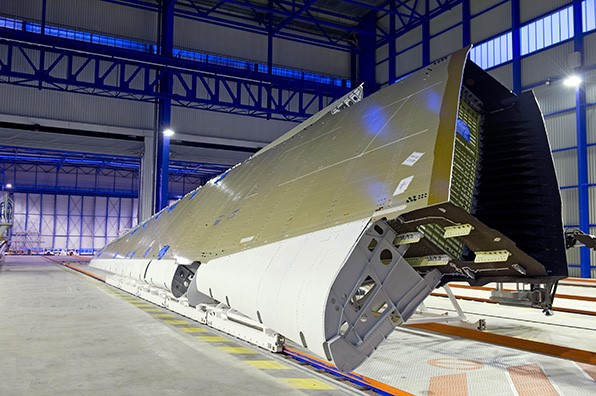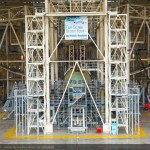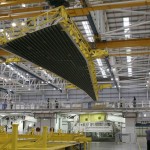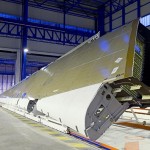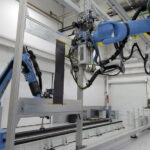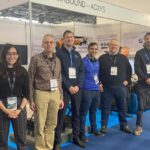di Mario Pierobon
Boeing
In April 2014 US patent number 8,703,268 entitled “Morphing panel structure” was assigned to Boeing. The patent document abstract refers to a panel structure which includes a composite face-sheet and a stiffening core having a plurality of core members in an intersecting web configuration provided on the composite face-sheet.
The background information reported in the patent document reads that “morphing panel structures may be useful in aerodynamic applications in which large pressure and temperature gradients or loads may be applied to an airfoil or other surface. The aerodynamic functionality of morphing panel structures may require a delicate balance between the flexibility and the structural support capabilities of the structures. Conventional panel structures in aerospace and other applications may be inordinately resistant to in-plane deformation. Therefore, it may be desirable that morphing panel structures which are suitable for aerospace applications be resistant to out-of-plane bending or flexing deformation while remaining amenable to in-plane deformation”.
The inventors’ summary information for this patent reads that “the disclosure is generally directed to a panel structure which is resistant to out-of-plane bending or flexing deformation while remaining amenable to in-plane deformation. The panel structure may be amenable to aerospace and other applications. An illustrative embodiment of the panel structure includes a composite face-sheet and a stiffening core having a plurality of core members in an intersecting web configuration provided on the composite face-sheet”
“In some embodiments – also reads the patent’ summary information – the panel structure may include a composite face-sheet including a plurality of reinforcing layers of reinforcing elements and core webbing attaching the reinforcing elements to each other and a plurality of elastomeric matrix layers laminated with the reinforcing layers in the composite face-sheet. A stiffening core may be provided on the composite face-sheet. The stiffening core may include a web configuration of intersecting core members and a plurality of core spaces defined by and between the core members”.
“The disclosure is further generally directed to a method of fabricating a panel structure. An illustrative embodiment of the method includes providing a composite face-sheet, providing a stiffening core and attaching the stiffening core to the composite face-sheet” reads the patent document.
“In some embodiments, the panel structure may include a first composite face-sheet including a first plurality of reinforcing layers of reinforcing elements, core webbing attaching the reinforcing elements to each other and a first plurality of sheet spaces defined by and between the reinforcing elements. A first plurality of elastomeric matrix layers may be laminated with the first plurality of reinforcing layers in the first composite face-sheet. A stiffening core may be provided on the first composite face-sheet and may include a web configuration of intersecting core members and a plurality of core spaces defined by and between the core members. A plurality of openings may be provided in the core members. A second composite face-sheet may be provided on the stiffening core and may include a second plurality of reinforcing layers of reinforcing elements and core webbing attaching the reinforcing elements to each other. A second plurality of sheet spaces may be defined by and between the reinforcing elements. A second plurality of elastomeric matrix layers may be laminated with the second plurality of reinforcing layers in the second composite face-sheet” reports the patent document.
The summary section of the patent document concludes with the following remark: “the disclosure is generally further directed to a method of changing shape of a structure to be morphed. An illustrative embodiment of the method includes providing a morphing panel structure, providing actuators in the morphing panel structure, providing a structure to be morphed, incorporating the morphing panel structure into the structure to be morphed and changing shape of the structure to be morphed by operating the actuators in the morphing panel structure”.
The patent document is complemented by a set of illustrations and a detailed description of the functioning of the patented concept.
Airbus
The competing manufacturer from the other side of the Atlantic, Airbus, is actually ready with a wing that adapts during flight on its brand new A350 XWB (extra wide body) due to enter service at the end of 2014 with Qatar Airways.
The European manufacturer has apparently been “mentored” by nature in the design of the A350 XWB’s wings. “Conditions change – aircraft take off with full tanks of fuel so the amount of lift needed decreases. So what you’d like to do is have a series of wings, each optimised for different conditions. This is what we’re trying to do with the variable camber and differential flaps” reported in 2010 Airbus’ senior manager of flight physics to Flight International. “If you look to birds you see them do this all the time, especially in long-duration flights. They are twisting and bringing their wings in to adapt to conditions”. This has been the inspiration in the development of the wings of the A350 XWB which indeed represent an industry milestone.
Since the development of the A320, Airbus has designed the flight-control system to automatically alleviate the effect of sudden gusts of wind, taking its inspiration from the wing feathers of birds, which act in the same way. Airbus has been continually improving this design, and on the A350 XWB it is at a point of significant refinement. Aircraft wing designers have drawn their inspiration from birds since the dawn of aviation and they are still finding ways of improving design based on examples found in the ornithological world.
The A350XWB features new composite wings with a wingspan that is common to the three proposed variants. Measuring some 32 metres long by six metres wide, the wing of the A350XWB is indeed the largest single civil aviation part made from carbon fibre composite material.
With an area of 443 m2 it is also the largest wing ever produced for a single-deck wide-body aircraft. The wingspan of 64.8 m is 4.5 m greater than that of the A330. This is the same span as that of the longer range variants of the Boeing 777, which have slightly less area. The wing tip does not have Airbus’s traditional wingtip fences, but instead curves upwards over the final 4.4 metres in a “sabre-like” shape. The new wing has a 31.9° sweep angle, helping to increase typical cruise speed to Mach 0.85 and maximum operating speed to Mach 0.89. All A350 XWB models share the same wing plan-form, with the exception of the small trailing edge extension for the A350-1000 version.
A new trailing-edge high-lift system has been adopted with an advanced dropped-hinge flap (similar to that of the A380), which permits the gap between the trailing edge and the flap to be closed with the spoiler. The manufacturer has extensively used computational fluid dynamics and also carried out more than 4,000 hours of low- and high-speed wind tunnel testing to refine the aerodynamic design, optimising it for fast cruise speeds that reduce trip times, improve overall efficiency and extend the aircraft’s range. By intelligently controlling the A350 XWB wing’s moving surfaces using on-board computer systems, the wing will be “morphed” while airborne – tailoring it for maximum aerodynamic efficiency in the various phases of flight.
Most of the A350 XWB wing is made of lightweight carbon composites, including the upper and lower wing covers, stringers, front and rear spars. The advanced structural design and superior wing aerodynamics are significant contributors to the aircraft’s 25 per cent fuel-saving performance. The A350 XWB in fact is a more efficient and quieter aircraft as a result of its advanced wing design.
Not only does the domain of commercial airliners seem to be active with regard to the development of morphing composite aero-structures. Business jet manufacturers apparently are also seeing some potential. Bombardier and Learjet have filed a patent application in June 2013 entitled “morphing wing for an aircraft”.
The summary of the invention in the patent application document reads that the invention addresses one or more deficiencies associated with wings known in the prior art. The invention provides, among other things, a wing for an aircraft where the shape of the wing may be altered along its lateral axis (e.g., along the span of the wing). In one embodiment, the invention provides a morphing wing for an aircraft. The morphing wing includes a top surface, a bottom surface, a leading edge, a trailing edge, a tip, and a root. The root is adapted for connection to the aircraft. A longitudinal axis is defined from the leading edge to the trailing edge, and a lateral axis is defined from the tip to the root. A plurality of structural ribs is disposed between the root and tip. The structural ribs extend between the top surface and the bottom surface and intersect with the lateral axis. At least one active member connects between two adjacent structural ribs at a first angle to the lateral axis. At least one active member is actively adjustable. At least one passive member connects between the two adjacent structural ribs at a second angle to the lateral axis. At least one passive member is passively adjustable. Adjustment of the at least one active member moves the adjacent structural ribs with respect to one another, altering at least one of the lateral axis or the longitudinal axis from a first shape to a second shape, thereby morphing the wing from a first configuration to a second configuration.
Didascalie figure, nell’ordine:
– Carried out on Airbus’ A350 XWB static test airframe, the next-generation jetliner passed ultimate load wing testing in December 2013 – handling applied loads of up to 1.5 times greater than an aircraft would encounter during its in-service operations
– A350 XWB Left Hand upper wing cover being lifted into the first Main Assembly jig (Jig C) at the A350 North Factory in Broughton, UK
– Airbus’ A350 XWB wing is some 32 metres long by six metres wide, making them the largest single civil aviation part made from carbon fibre composite material


